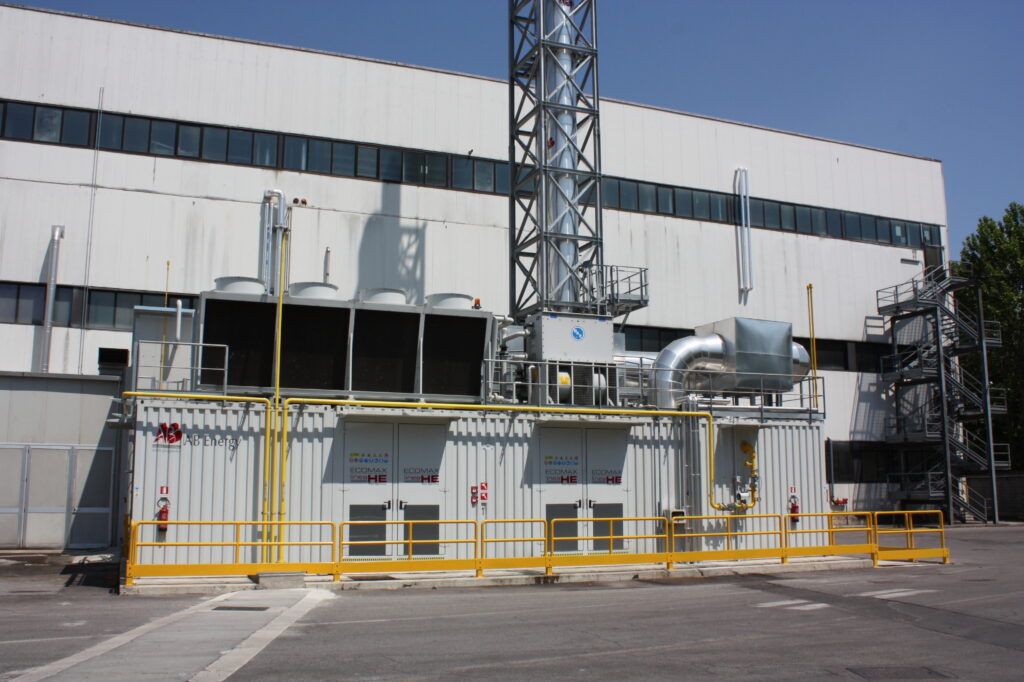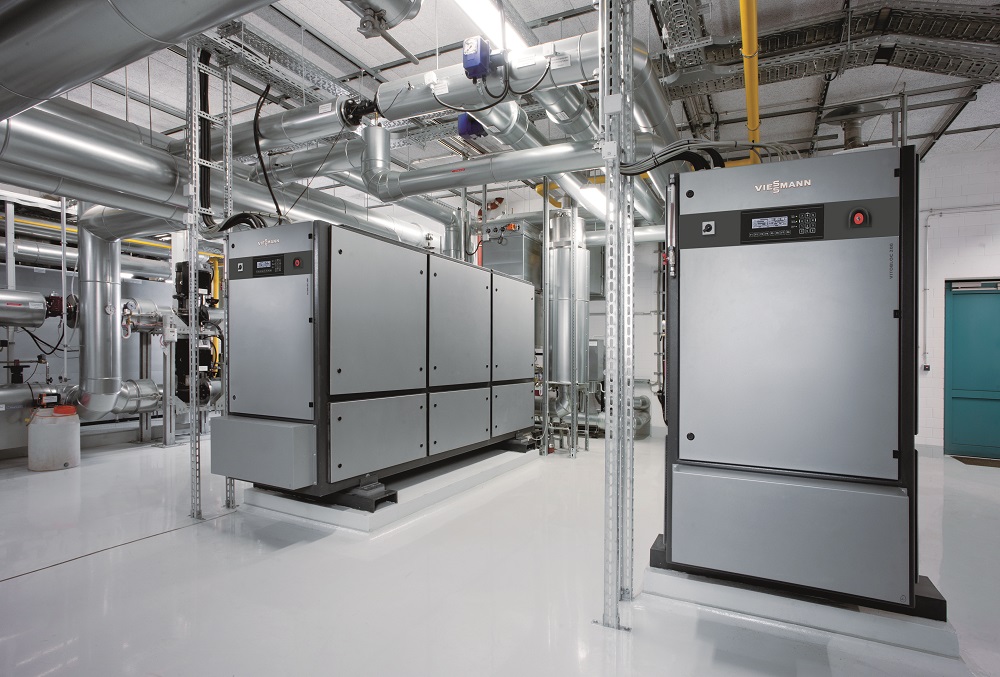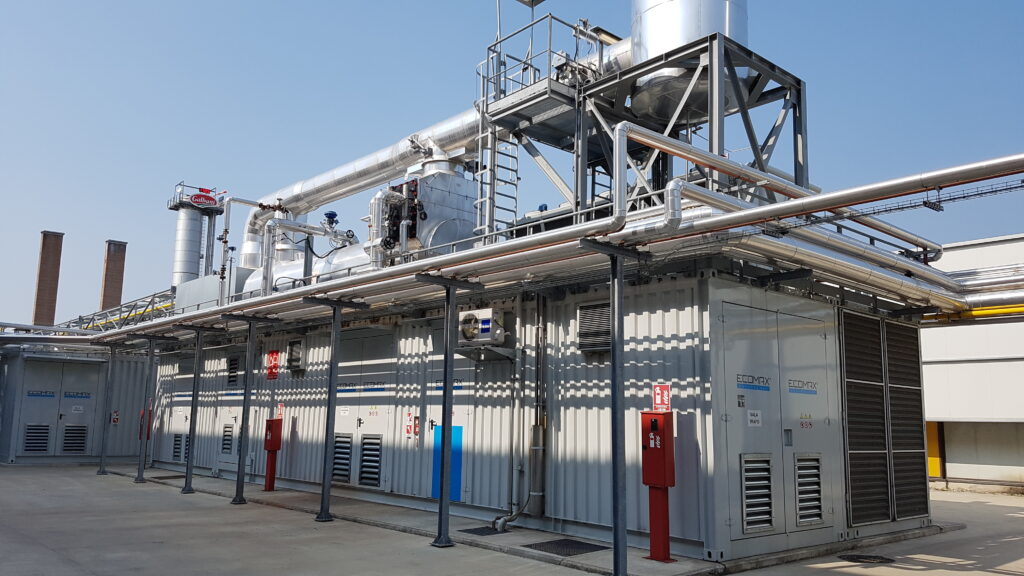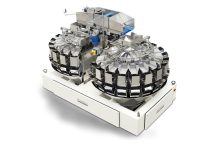
Cogeneration remains a very valid energy-efficient tool in industrial production. Trigeneration is also of particular interest for the food sector, thanks to particular technological innovations.
In the field of energy production, a plant can be defined as ‘cogeneration’ when it satisfies certain conditions: it achieves a primary energy saving (of fuel, for instance) compared to alternative solutions (purchase of electricity from providers and production of heat with a boiler) and it uses the most rational thermodynamic process to convert the potential energy of fuel, thanks to the simultaneous generation of mechanical/electrical and thermal energy.
With regards to refrigeration industry, a ‘trigeneration’ plant is defined when, in absence of an adequate thermal demand, the cogenerated thermal energy described above is used (in whole or in part), to generate cooling energy with a machine called absorption refrigerator. In the absorption refrigeration cycle, the transformation of thermal energy into cooling energy is based on the transformations of the coolant status in combination with an absorber. The refrigerant/absorber pairs used are basically: water/lithium bromide for fluid temperatures up to 1°C and water/ammonia for sub-zero temperatures.
Cogeneration modules
In the industrial sector, as well as in the tertiary and residential sectors, users often need to different types of energy: electrical and thermal energy. If these needs are met with two different energy-generating structures, an energy balance is achieved(performance), which, although it varies according to the size and the energy/heat ratio, can roughly estimated as 40% for electrical energy (National Electrical System) and 90% for heat (boiler).
In the case of a single generative structure (basically an endothermic engine, of an alternative type, but also a gas turbine), the energy balance increases enormously to over 90%. Total energy systems are thus a single solution to two (or more) problems that can be solved separately, each on its own account (Fig. 1). The production of electric energy achieves, as mentioned, efficiencies between 35% and 45%. The remaining 55-65% is energy spent on:
– Friction, which is transformed into heat transferred to the lubrication oil.
– Heat transferred to the cooling water of the engine components.
– Heat released by the exhaust gases and dispersed with them.
In cogeneration plants, these energy shares are largely recovered through the use of exchangers, which are installed in the oil and water s cooling circuits and on the gas exhaust pipes. The sizing of these elements is such as to ensure a global heat exchange that can be estimated at 80-85%, without however pushing the exchange with the exhaust gas to the point of condensation, which is dangerous for materials. From the operational point of view, the main issue of cogeneration mainly concerns the correspondence between energy production and demand, both on the electrical and on thermal side: it isn’t enough to achieve overall generation efficiency so close to one unity, if the energy made available by the operation cannot be used rationally.
Therefore, when studying the feasibility of a project involving the installation of cogeneration modules, it is appropriate to check the size and functional features of the modules, while studies on the dynamics of the process allow to reach the optimal solution. In particular, the following guidelines should be considered in actions leading to cogeneration choice:
– Analysis of the economic and energy balances resulting from the simulation of a ‘typical year’ of operation, defined in terms of:
- Technical characteristic of the plant.
- Temporal evolution of user requests.
- Value of energy products produced and consumed.
- Optimization of plant management, in order to obtain the maximum economic return, in the various periods representing a typical year.
– The possibility of optimally managing the plant in presence of a possible heat accumulator that, on a daily basis, releases the thermal production of users’ demand.

Cogeneration Units
A cogeneration unit consists essentially of:
– An internal combustion engine running on fuel which may be natural gas or biogas.
– An electric generator.
– Heat recovery units (from oil, cooling water. exhaust gas), with related servo-valves, connecting pipes, thermo-regulators.
– A heat-disposal device for dissipation, even total, of the heat, if the unit is to produce electricity only, complete with an electric fan.
– Safety devices, consisting of a series of visual and audible alarms, which highlight anomalies which may occur during the operation of the unit, such as: low engine water level, low engine oil level, low engine oil pressure, engine water pump functionality, heat dissipation device functionality.
– Motor generator unit support, generally made of strong steel profiles. The motor-generator complex is connected to a frame by means of elastic supports, which in turn rests on the ground.
In the case of small units, even for industrial use, the modules are very compact and integrated, so that they have a particularly ‘clean’ appearance and can be easily integrated into an existing heating plant (Fig. 2).
Trigeneration
Trigeneration is the combined production of electricity, heat and refrigeration, and is applied in all situations where the heat made available by the cogenerator is not used in the production process or is partially used. After a careful feasibility study that analyzes all the thermal needs of a company, a wide range of thermal vectors can be found, which can be steam, diathermic oil, superheated water, hot water and cold water.
Steam, diathermic oil and superheated water are produced by exploiting the high temperature heat extracted from the exhaust fumes. Very often these carriers are the most requested by industries, but the thermal level of heat shouldn’t be forgotten. More than half of the heat produced by the system comes from the engine cooling water, so close to 90°.

Therefore, in order to fully exploit the heat, it is necessary to use the water at a medium temperature. If the industrial process does not use all the hot water or it is used only for the heating process (i.e. at low temperature), it can be sent to an absorber that uses this heat as incoming thermal power and is capable of generating cold water (Fig.3). These devices, already well-tested (their invention dates back to the second half of the 19th century) were conceived to be fed with thermal vectors such as steam or superheated water, exploiting the thermal waste from energy-intensive industrial processes (originally cement factories, steelworks and glassworks). For some decades, absorbers have been combined with cogeneration plants, using hot water at 90° as an input carrier, with the limit of being able to produce cold water at a temperature of not less than 5°/6° (lithium bromide absorbers). A different story should be told for ammonia absorbers, which can reach temperatures well below zero; however, they have only recently been introduced in European applications, where the market had shown some mistrust towards them.
As a result, in recent years there has been a great evolution for both: lithium bromide absorbers have seen a great technical evolution and they have been re-designed to receive incoming hot water at 90°; this technological upgrade, aimed at combining with trigeneration plants has increased the yield and, above all, has allowed to reach the minimum temperature of 1°C. As far as ammonia absorbers are concerned, applications in Italy and Europe have multiplied and the market mistrust that existed until a few years ago has completely disappeared.
This innovation has revolutionized the world of trigeneration, because it has opened new market scenarios, especially in the food industry. In the air conditioning of work environments, for example, typical water temperatures of absorbers of 7°C at the outlet and 12°C at the inlet are perfectly fine for civil air conditioning (which are around 20°C) and for most industrial applications, but they are not sufficient for the food industry, which requires much more stringent conditioning that goes down to much lower temperatures, such as the 12°C in the meat sector.
In the dairy sector the production of cold water is often entrusted to ice storage tanks, which have the advantage of producing water at 1°C. Likewise, the milk and dairy sector has hitherto been able to exploit the enormous benefits of cogeneration only when companies were able to make full (or almost full) use of the heat produced by the cogenerator, but found it impossible to apply an old-fashioned absorber because it was impossible to use cold water at 6°C (Fig.4).
Today, with the advent of lithium bromide absorbers that can produce non-glycoled water at 1°C and the affirmation of ammonia absorbers for the production of glycolated water ‘below zero’, new market scenarios are opening up, which will see many new applications, in particular in the food industry.

Future scenarios
In terms of energy efficiency, cogeneration holds a relevant position in terms of investments when compared with other technologies. And if future co-/ trigeneration scenarios are envisioned, they may be moderately optimistic for a number of reasons:
– The technological upgrade of absorbers will certainly open new market scenarios, especially in the food industry;
– A possible economic crisis can only push companies to look for smart ways to cut costs, without acting on the quality of products and services. When companies don’t have the liquidity to support new investments, the market offered several financial solutions that allow companies to install a new plant, without up-front costs;
– The necessary competitiveness exacerbated by an economic crisis is pushing companies more and more to tackle issues, such as energy efficiency, which were unfortunately neglected in times of greater prosperity;
– The search for maximum efficiency has led many companies to better monitor the thermal carriers to be used and this certainly facilitates the work for those who will produce a feasibility study for a co-/trigeneration plant;
– Increasing awareness of environmental problems rewards companies that adopt more efficient production systems and reduce global pollution; this means that the installation of a co-/-trigeneration plant can now be a marketing vehicle for companies producing consumer goods (such as food, pharmaceutical or household chemicals companies).
Conclusions
In times of crisis the watchword is ‘react’, and, cogeneration can be a winning move, as we have seen, from every point of view. Here too, however, it’s necessary to deal with the bureaucracy, which sometimes makes authorization procedures complex.
However, if the approach is one that fits into the broader context of ‘energy efficency’, really interesting opportunities could open up: in fact, linked to energy efficiency are the efficiency of the production systems as a whole, and the beneficial effects on plant maintenance. Seeing all these aspects linked and enhanced in a unified way is the great challenge of the modern food industry.



